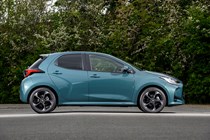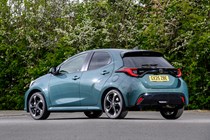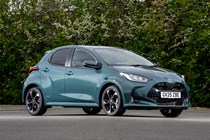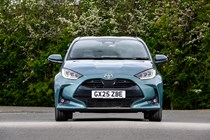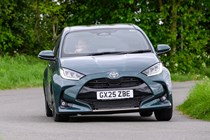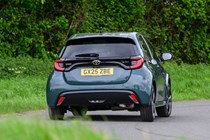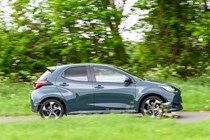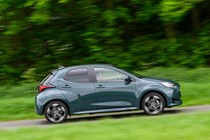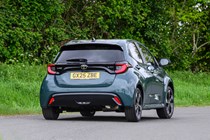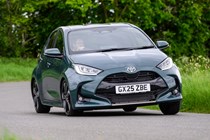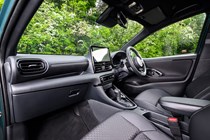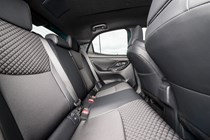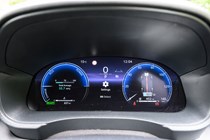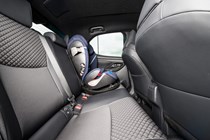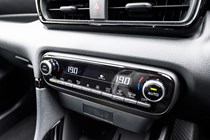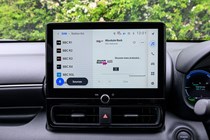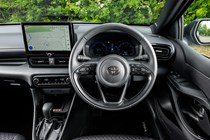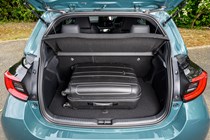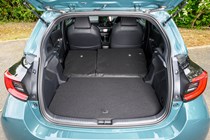Toyota Yaris long-term test
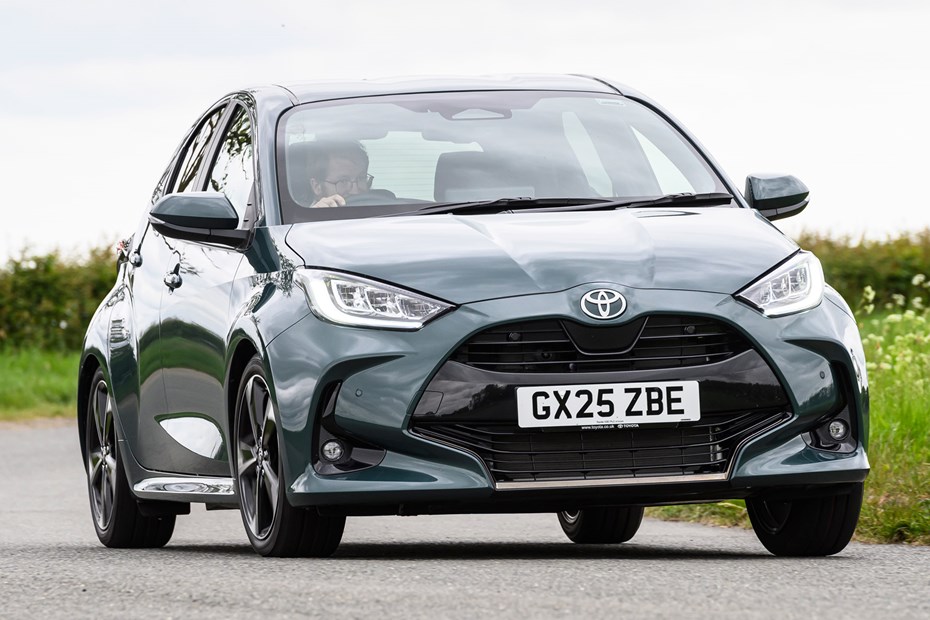
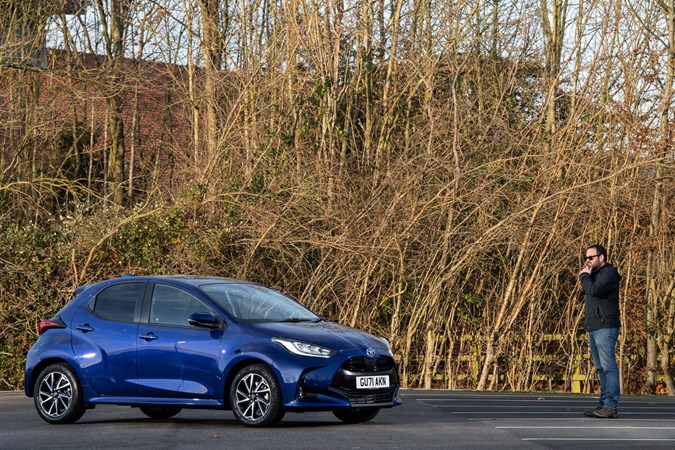
This new Yaris hybrid has piqued Gareth’s engineering passion with its clever engine and electric motor combination. But what’s it going to be like to live with over an extended period? He’s going to spend six months finding out…
Update 1: Welcome to the fleet!
By Gareth Evans
I’m really passionate about decent engineering, as boring as that sounds. It’s a hobby of mine as well as a professional pursuit, and that’s the primary reason I’m absolutely fizzing with excitement for running a Toyota Yaris Hybrid on a long-term test.
It wasn’t a very long time ago that the Yaris was a little, well, boring. I remember going to its French factory half a decade whence, and being impressed by the near-laboratory conditions, but less so with the car’s ultimate lack of character.
But I bet Toyota’s done it this time around. Just look at the reception the fast version – the GR Yaris – enjoyed in the motoring press. That’s because the Yaris sits on Toyota’s TNGA-B platform and as such is built with enjoyment in mind. It should be fun.
Plus it’s a hybrid: a 1.5-litre petrol engine with help from an electric motor to help it sip less fuel. Toyota were first to market with one in the form of the Prius back in 1997, so they’ve been at it a while, and I’m expecting big things from a car that is supposedly capable of 57.7mpg or more.
Why? Because that equates to a usefully long range of over 450 miles, which is huge for a car of this size. It’s the antitheses of all the 100-miles-if-you’re-lucky EVs we’re rapid becoming used to living with.
Toyota Yaris Design hybrid spec highlights:
- 16-inch alloys
- 8.0-inch multimedia screen with Apple CarPlay and Android Auto
- LED daytime running lights, headlights, front fog and rear combination lamps
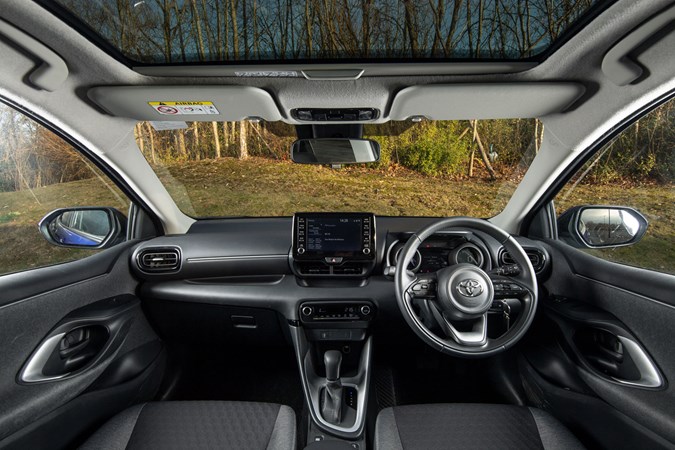
Do you have any optional extras installed?
Only two, but in my mind they make a big difference. The Galactic Blue paint is £585 and I like it very much. It’s a little more grown up than some of the other hues, which gives me the impression this is a more sophisticated small car – more akin to a sensible Audi A1 or VW Polo than a cool-but-quirky Corsa.
The other is a full-length panoramic glass roof, weighing in at £495 on top of the £21,270 asking price. Total for the car as you see in the pictures is £22,350 at time of writing.
What does a Toyota Yaris Design cost on finance?
But hardly anybody pays for cars outright these days. Finance is far more fashionable, and Toyota’s offering 0% APR on the Yaris if you get a PCP deal.
What does that mean in cold hard monthly payments, though? If you can find a £2,235 deposit and limit yourself to 8000 miles per year, it’ll cost you £280.88 a month over 36 months, with an optional final payment of £10,282.50 to pay at the end of the PCP if you want to buy the car outright. Otherwise, hand the keys back to Toyota or talk to them about whether they can offer a deal on another car in part exchange for your Yaris.
The figures quoted above are representative, but you’re able to lower the deposit by selecting a longer PCP or higher monthly payments, or a combination of both. Likewise, you can lower the monthly payments by looking at a bigger deposit or longer term.
So there we go. Groundwork has been laid for six months sussing out this small five-door hatchback. I can only hope I’m as sad to see it leave as I am excited to be holding the key.
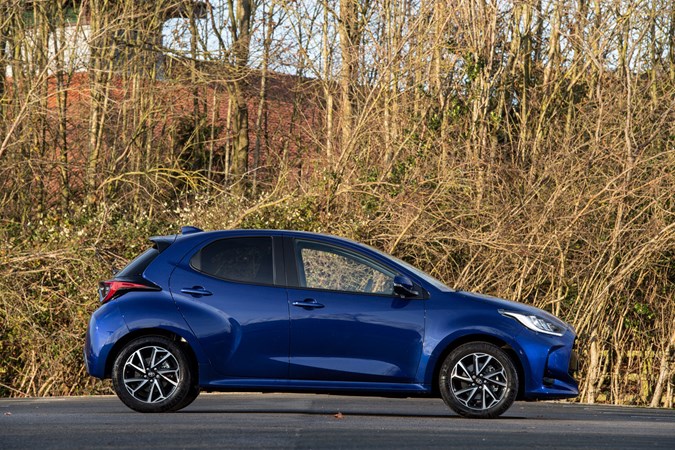
Update 2: First impressions 1000 miles in
By Gareth Evans
From my first thousand miles with the Yaris design, I’m thrilled to report this car seems brilliant.
Not only does it easily do 450 miles between fill-ups thanks to the seriously impressive hybrid system (1.5-litre petrol engine with an electrical motor to lighten the load on fossil fuel consumption – currently claiming 56mpg), but it does so with the type of composure you’d expect from far posher car manufacturers. Premium sister brand Lexus could quite easily rebadge a Yaris and not one customer would be left wanting.
Part of it is the build quality, which is seriously impressive. Although the doors can sound a little tinny (which incidentally keeps the weight down), the cabin is beautifully screwed together with laser-sharp panel lines and just enough styling to be interesting.
I’m a huge fan of the fabric front seats. Why does everyone want leather anyway? Fabric heats up and cools down quicker, and doesn’t scratch or get sticky in the sun.
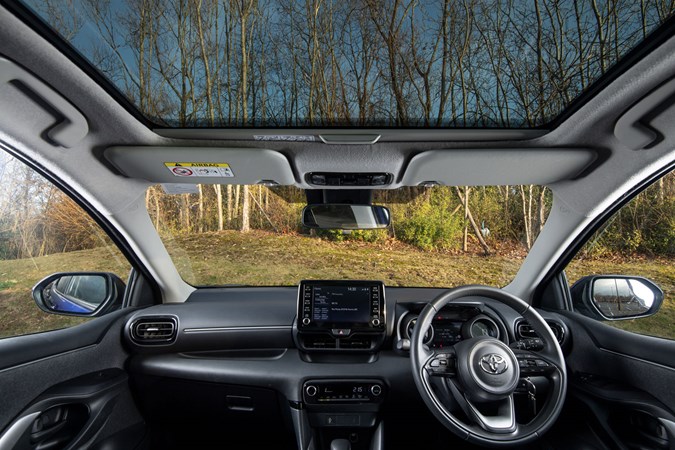
But something else that adds to the impression of quality is that full-length glass roof. It doesn’t open, but because the windscreen is a long way from the driver in this generation of Yaris, the roof makes the cabin feel massive, despite this being a small car.
And I love the powertrain already. The hybrid system in this iteration is so impressively developed. It’s really smooth and almost silent when in electric mode (although there’s a spaceship-type noise from the outside so pedestrians can hear you at slow speeds), but the biggest surprise for me was the 1.5-litre petrol engine’s peppy performance. It feels like it’s got a lot more oomph than its 115hp would suggest, and it sounds distinctive too because it only has three cylinders. Just like my last motorbike.
I’ve not had much chance to engage too much with the handling yet, but one thing’s clear: it’s an easy car to park, both parallel and in reverse. The huge amount of glass around the driver helps a lot here, and so does a smaller turning circle than some rivals.
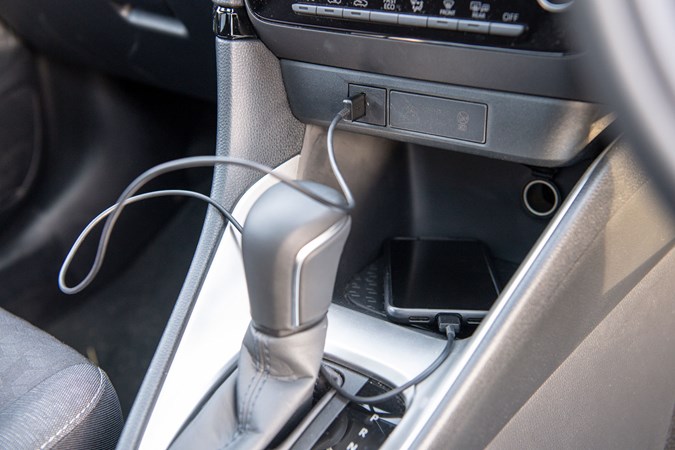
What don’t I like? Well, I don’t like using cables to plug my phone in so I can use Android Auto, but I’m thankful the Yaris’s USB is positioned next to the cubby. A deceptively simple but often overlooked design feature, if my previous Suzuki Swace was anything to go by.
We’ve been through a pretty chilly snap recently, which gave me a chance to test the Yaris’s cold weather capabilities, and I’m pleased to report nothing remarkable: it warms up quickly, drives perfectly well on slippy roads without bothering the traction control too much. I do wish those fabric seats were heated for early morning runs, but that would be a luxury on a car of this size rather than the norm.
And it has a key! This is increasingly unusual these days, in lieu of keyless ignition, and I have to say I’m preferring the physical item. It’s the perfect protection against car thieves using reflector devices to fool the car into thinking the key is present and making off with your motor. That’s simply impossible with an actual key.
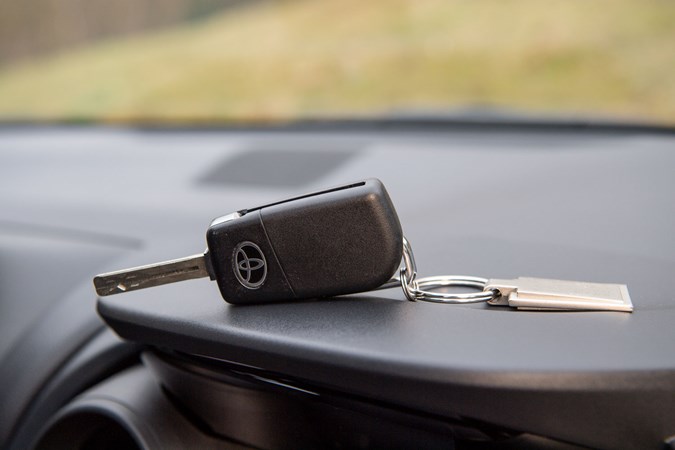
That’s about it from my first 1000 miles. I’m loving the Yaris Design more each day, but need to start putting some more serious miles on it. An impending trip to the sunlit uplands of Birmingham is on the cards first. Lucky me…
Miles: 1000
Fuel economy: 56.6mpg
Update 3: Living with the Yaris through winter
By Gareth Evans
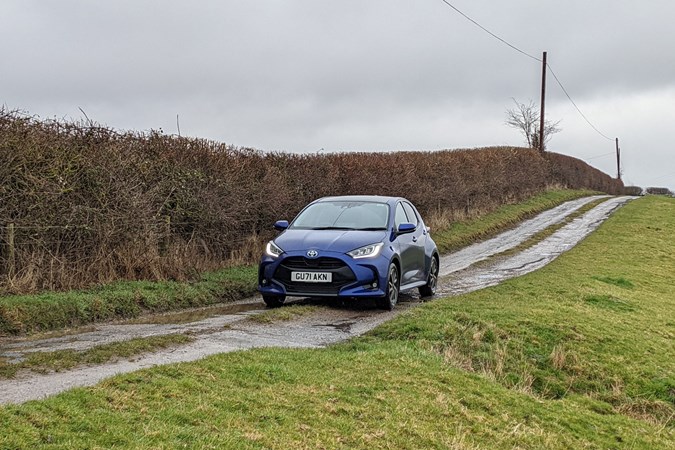
The 28th of February marked the final day of metrological winter, meaning the Yaris beat everything the slippery season threw at it, which is to say a number of storms, including the second biggest I’ve ever experienced in the UK – the innocuously named Eunice. It also explains why it’s absolutely filthy. Sorry about that.
You see, where I live there is one constant through the darkest months: mud. It gets everywhere – spread onto the roads from the surrounding fields, stuck in the tread of my boots, and naturally covering the car I’m using, both inside and out.
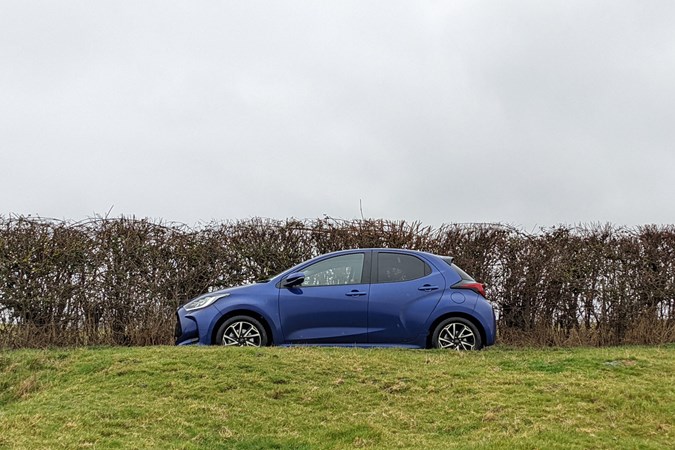
Still, a bit of dirt never hurt anybody. It’ll quickly wash off. What I was very thankful for during those abnormal weather events was this Toyota’s sheer simplicity. When it’s blowing 50mph outside, being able to hop in, select D and drive away takes a lot less concentration than with a manual gearbox.
I do wish the active lane-keeping steering worked more accurately, though. On my local lanes I’ve noticed it’ll try to steer me into sub-optimal road positions, which is more of a problem when there’s an oncoming vehicle I’m trying to steer to avoid.
I’ve simply taken to holding my thumb on the steering wheel-mounted button for three seconds every time I set off to deactivate the system, but hey – you pay for this stuff so I’d prefer it worked properly, regardless of whether it’s mandatory for crash safety regulations.
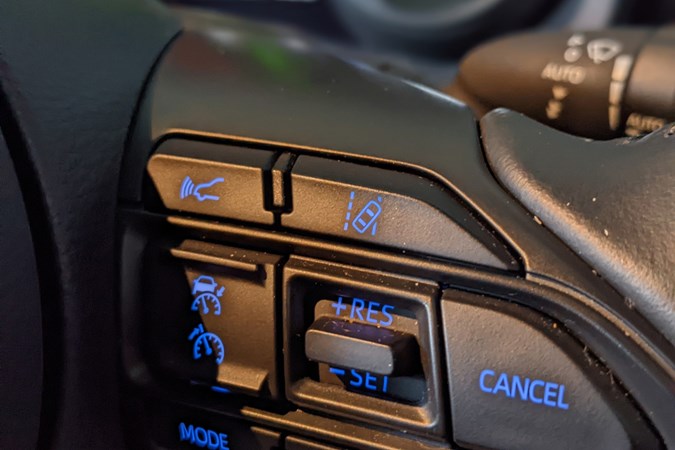
Another issue that’s irksome has nothing to do with the car, but my phone (a relatively recent Google Pixel 5) quite often gets confused when I plug it in, and won’t operate Android Auto. My only option at this point is to reboot my mobile, which is time-consuming and fiddly when parked, and illegal when driving as I need to enter my PIN. Again, sub-optimal, but I’m convinced it’s not the Toyota’s fault.
In fact, I’d forgive this little scamp a lot. It’s a massively characterful machine. I love the thrum from the plucky three-cylinder 1.5-litre petrol engine, and it’s surprisingly pokey too.
I’m finding fuel economy varies quite a bit based on the type of driving I’m doing, but on my local roads it’s at its best, between 30-60mph with gentle acceleration. It’s no exaggeration to say that 60mpg is a realistic figure. This drops a bit the quicker you go, but still 50mpg is realistic on the motorway.
I found that out when driving to the ExCel centre in London recently for a trade show. Isn’t the M11 just lovely? But seriously, it’s a brilliant car for a journey like that, because not only is it smooth and quiet, it also qualifies for no charge in Sadiq Khan’s new ULEZ areas. It took me a while to figure that out on the somewhat confusing Government website, but alas, the Yaris’s 92g/km CO2 output is low enough to drive here for free, but it doesn’t apply to the Congestion Zone – that’s something else entirely.
Anyway, the final word from me this month comes from my Mum, who’s recently moved nearby and has been sitting in the back on a variety of occasions. She loves the panoramic glass roof, which means it doesn’t feel like a small car, and also lets her look at the ubiquitous Red Kites circling overhead. They didn’t have those where she was before, and that novelty takes quite a while to wear off.
Mileage: 4355
Fuel economy: 56.3mpg
Update 4: What happened to spring?
By Gareth Evans
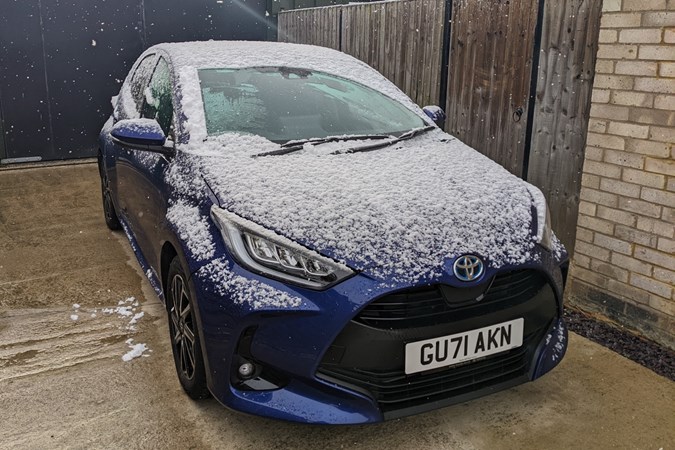
I thought we’d seen the back of winter after a couple of weeks of glorious sunshine in March, but alas April came along and blew that right into the weeds. We’ve had sleet, snow, hail, wind and pretty much everything else the British weather can muster.
But the plucky Yaris has shrugged it all off. Even on the coldest of mornings it heats up very fast indeed, which is a bonus when the mercury drops to minus degrees centigrade. The only issue is an overactive tyre-pressure monitor, which seems to give me a warning whenever it’s close to freezing. A check of the pressures was all that was required to see this was erroneous, though.
You’d expect a new car to fare well in inclement conditions, but what I was really surprised with was the flexibility in this Fiesta-sized machine.
I’ve been transporting my wife and parents around a fair bit, and I’ve had several comments about how light and airy the cabin feels, even in the back. That’s thanks in no small part to the panoramic glass roof, which extends the windscreen right to the back of the car. It’s a feature I dearly love in most scenarios, but when it’s hot the cabin does tend to become a little uncomfortable until the air-con kicks in.
I’ve been doing some surprisingly enthusiastic tip runs in the car too, by which I mean carrying far more junk that I was expecting. The back seats are easy to fold down as long as you remove their headrests first.
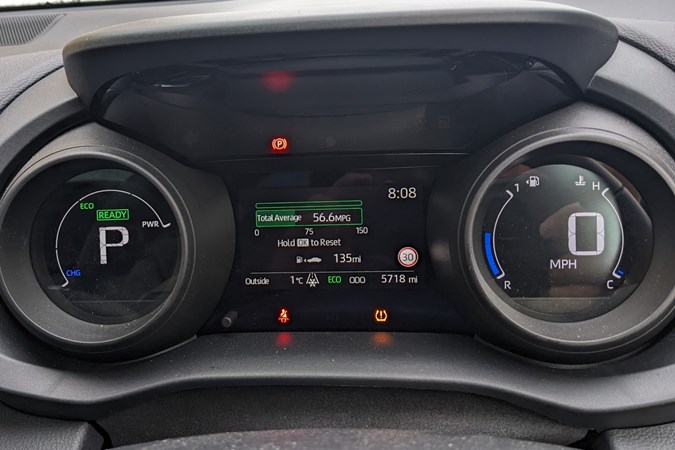
It’s doing a fantastic job of being all the car many people would ever want, in fact. I’m still surprised how often it’s using electric power rather than the 1.5-litre petrol engine, and 56mpg average is the norm when I’m not concentrating. That goes well above 60mpg if I try, but where’s the fun in that?
Besides, with petrol prices the way they currently are, nudging £2 a litre in some places, for most it’s becoming essential to have a car that sips fuel in a miserly fashion. The Yaris does that seriously well.
I have discovered another bugbear, though. I previously complained about the lane-keeping system defaulting to ‘on’ every time I start the car, but another driver-assistance ‘feature’ has been frustrating me recently. The Yaris seems to think I’m going to crash into other vehicles fairly often, and activates its emergency warning – a loud beep and a message on the dash – for seemingly innocuous situations.
It’s usually a stationary car parked at the side of the road, and while I accept that it’s possible my driving is causing this, I’ve never experienced such neurosis from another other vehicle. At no point have I ever felt in danger of hitting another vehicle.
Thankfully it hasn’t yet activated the automatic braking system, because that would mean it goes from simply annoying to somewhat dangerous, but I could do without this type of help.
And finally, a word on keeping your Yaris clean: if you don’t, the reversing camera will become dirty and effectively stop working as the screen is useless. That really is user error, though. I’ll try to keep it tidier in future.
Mileage: 5343
Fuel economy: 56.6mpg
Update 5: Spec secrets and minor moans
By Gareth Evans

I’ve found some curious things about the Yaris’s design recently. In my previous update I explained how simple it was to fold down the rear seats, for example, only to find out that you have to remove the rear headrests with the seats partially folded and put them back the same way – the roof gets in the way if you try to do it when they’re in their proper position.
Still, this is a small car. I keep having to remind myself of that because very often it doesn’t feel like it. The range alone – 400 miles per fill-up – smacks of something far larger, and the glass panoramic roof makes the cabin feel massive.

Another slight design quirk is the cupholder arrangement, with one obscured by the central armrest. There’s a larger one in both door pockets, though, so not the end of the world. I’m also getting slightly bored of the physical key required to start the car, because I can rarely get it into its hole first time and as such I’ve scratched the plastic on the steering column.
Can you tell I’m scraping the barrel here trying to find faults? The Yaris, in one-up-from-entry-level Design specification, represents a fantastic car and I honestly don’t think you’d be too disappointed. In fact I’ll think you’ll have made a brilliant buying decision.
Or indeed a fine financing one, because if you stump up £5420.96 as a deposit at the time of writing, you’ll pay £189 a month for this exact car over 42 months on a PCP. That’s at 1.9% APR. Very reasonable, and includes the optional Galactic Blue paintjob and glass roof.

Would I add anything extra if I were buying myself? Actually, I’m not sure. I’d like keyless entry and ignition, but that would necessitate a jump to Excel spec, and that’s another £1900. The other bits included in the upgrade to Excel – sports seats, parking sensors, an additional two speakers, wireless Android Auto – are nice to have but not essential. I’d stick with this spec instead.
While we’re talking specs, the feature I’ve used the least on the Yaris (other than the irritating lane-keeping system I switch off every time) is the drive modes. I’m not really too sure why you’d want to put a car like this into Sport mode, and it’s so impressively efficient just driving around in the default setting that choosing anything else seems folly.
The engine and electric motor continue to impress massively. My driving now accounts for the additional slowing effect of the motor regenerating electricity, which means I use the brakes less and can maintain momentum. I’m always impressed how far it manages to do this for – slowing down exactly the right amount and no more.

There is a little jolt when you pull up slowly to a stop, though. Presumably this is a function of the brakes grabbing to prevent the car being shunted forward in an accident, but on occasion it can be slightly disconcerting.
Minor foibles for the Yaris Design. It continues to be a wonderful companion and I’m going to miss it when the time comes to say goodbye.
Mileage: 5569
Fuel economy: 56.6mpg
Update 6: Goodbye
By Gareth Evans

So, after six months with the Yaris and it’s time to wave goodbye. What a shame! It’s been one of the better cars I’ve had the privilege to live with over recent years.
I say ‘recent’, because cars have changed considerably in the past few, and now we have mandatory ‘driver-assistance’ kit along with many methods of cutting greenhouse gas emissions and saving that all-of-a-sudden astonishingly expensive fuel.
And that highlights both the highlight and lowlight of life with the Yaris. The lane-departure and automatic emergency braking systems have both proven problematic for me in my rural location, while the engine with its electrical assistance is a remarkable bit of kit.
I adore the range of this car. As fuel gets increasingly expensive, being able to do 400 miles between frightful trips to filling stations is a real bonus.
But it’s not at all straight-laced either. The underlying chassis is genuinely great fun to drive, despite a point-and-shoot automatic transmission. The 1.5-litre engine with 116hp is just right for the size of vehicle, and even sounds pretty peppy. I can only imagine what the hardcore GR Yaris hot hatch must be like.
Plus this particular car does a great Tardis impression thanks to its glass roof, stretching from the windscreen right to the bootlid. This makes the cabin feel huge, and particularly so for back seat occupants.

The tech on offer was more than up to my demands, because smartphone connectivity through Android Auto is easy and low-maintenance. Sure, it still needs a cable to connect, but I simply can’t find any reason to pay extra for built-in sat-nav these days.
Some longer journeys gave a chance to test its mettle in city centres – navigating low-emissions zones for free thanks to the low CO2 output – and it was as faithful in that environment as it was on the motorway. Fuel economy suffers a bit at 70mph, but that’s to be expected as drag increases exponentially with speed.
Anyway, it’s hardly something to complain about when the economy remains over 50mpg regardless.
I’m not even sure I’d pick a different spec of Yaris. Design trim has everything I need from a car, as long as you get the glass roof as an extra.

So should you buy a Toyota Yaris Design? Nobody buys cars like this with cash anymore, but admittedly with a list pricing starting with a two it does look rather expensive. However, If you can afford a decently sized deposit on a PCP, I genuinely can’t think of many reasons not to. It’ll do everything you need, and do it cheerfully. I’m really going to miss it, and it’s set the bar incredibly high for the next car on the list.
Toyota genuinely seems to be on a roll of fantastic products right now.
Mileage: 6002
Fuel economy: 56.6mpg



